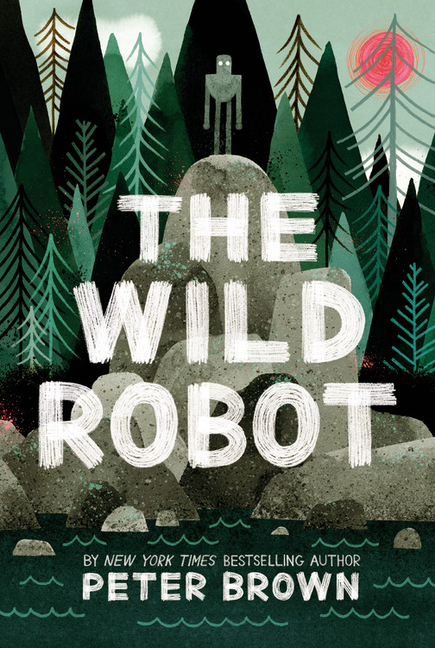Audiobook Excerpt narrated by Kate Atwater
The Wild Robot |
Audiobook excerpt narrated by Kate Atwater.
Translate this transcript in the header View this transcript Dark mode on/off
Kate Atwater: Camouflaging herself as a twig was out of the question. No, the robot would have to blend into the landscape itself. She began smearing handfuls of think mud over her entire body. Then, she plucked ferns and grasses from the ground, and sank their roots into her new, muddy coating. She placed colorful flowers around her face to disguise her glowing eyes, and any bare patches were covered with tree leaves and strips of moss.
Our robot now looked like a great tuft of plants walking through the forest. She waited for darkness, and then she patted to the center of a clearing, nestled herself between some rocks, and became part of the landscape. A few hours later, the sky was brightening. The fog was lifting. The nighttime animals were slinking home, and the daytime animals were beginning to stir. It was just an ordinary morning on the island.
However, there was that new tuft of plants in that one forest clearing. Only the bees had noticed the tuft. They buzzed around it, completely unaware that the robot was hidden beneath, and so Roz sat there, right in the open yet completely unseen and observed the wilderness around her. She watched flowers slowly turn toward the sun. She listened to rodents crawl through the weeds. She smelled the moist, piney air. She felt worms wiggle against her muddy sides.
A week later, the tuft of plants was gone, but there was a new clump of seaweed on the shore. A week after that, the clump of seaweed was gone, but there was a new bramble on the mountain. Then there was a new log on the river bank. Then a new rock in the forest.
Chapter 19: The Observations
Clouds scudded through the sky. Spiders spun intricate webs. Berries beckoned to hungry mouths. Foxes stalked hares. Mushrooms rose up from leaf litter. Turtles plopped into ponds. Moss spread across tree roots. Vultures hunched over carcasses. Ocean waves beat against the coastline. Tadpoles became frogs. Caterpillars became butterflies. A camouflaged robot observed it all.
Chapter 20: The Language of The Animals
It started with the birds. They had always been skittish when the robot was near. They would stare and screech and then scatter, but now that Roz was camouflaged, she could secretly observe their normal behavior right up close. Roz noticed chickadees fluttering through the same flowers and singing the same song every morning. She noticed a lark who swooped down to the same rock and sang the same song every afternoon. She noticed the same two magpies singing to each other from across the same meadow every evening.
After weeks of robotically studying the birds, Roz knew what each bird would sing and when they would sing, and eventually, why they would sing. The robot was beginning to understand the birds, but she was also beginning to understand the porcupines and the salamanders and the beetles. She discovered that all the different animals shared one common language. They just spoke the language in different ways.
You might say each species spoke with its own unique accent. When Roz first listened to the chickadees, their songs had sounded like, "Tweet, tweetle. Tweet, tweetle."
But now when the chickadees sang, Roz heard, "Oh, what a lovely day it is. Oh, what a lovely day it is." Deer spoke mostly with their bodies. By simply turning her head, a doe could say to her family, "Let's look for clovers by the stream." Snakes often hissed to themselves. Things like, "I know there's a tasty mouse around here somewhere."
Bees said very little. They used their wings to buzz a few simple words like nectar and sun and hive. Frogs spent much of their time searching for each other. One would croak, "Where are you? I can't see you." And then another would reply, "I'm over here. Follow my voice." When Roz first stomped across the island, the animal's squawks and-
This audio excerpt is provided by Hachette Audio.



